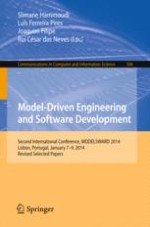2015 | Buch
Model-Driven Engineering and Software Development
Second International Conference, MODELSWARD 2014, Lisbon, Portugal, January 7-9, 2014, Revised Selected Papers
herausgegeben von: Slimane Hammoudi, Luís Ferreira Pires, Joaquim Filipe, Rui César das Neves
Verlag: Springer International Publishing
Buchreihe : Communications in Computer and Information Science
